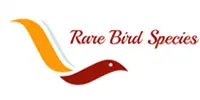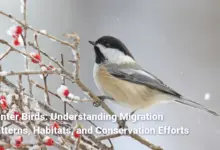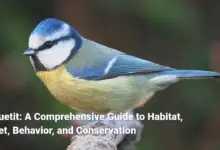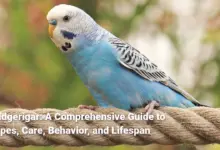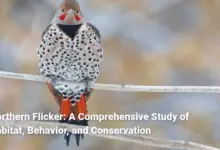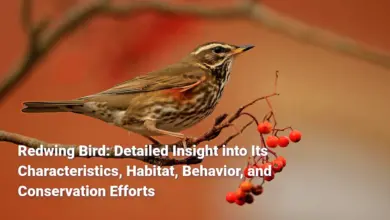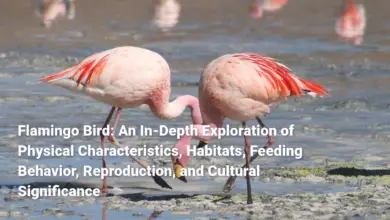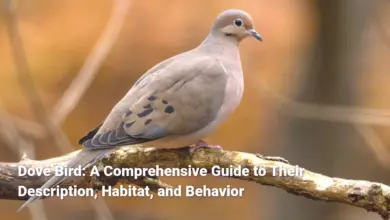Eclectus Parrot: Physical Traits, Habitat, Behavior, and Care
Welcome to the intricate world of the Eclectus Parrot, a bird as striking in appearance as it is fascinating in behavior. Renowned for their vivid plumage and remarkable intelligence, Eclectus Parrots (Eclectus roratus) are native to the rainforests of the Solomon Islands, New Guinea, northeastern Australia, and the Maluku Islands. These birds captivate avian enthusiasts with their unique sexual dimorphism males sport a vibrant green while females are adorned in red and purple which historically led early naturalists to believe they were two distinct species. Eclectus Parrots are not just visually stunning; they are known for their sociable and affectionate nature, making them beloved companions. This comprehensive guide delves into every aspect of their existence, from physical characteristics to dietary needs, offering insightful comparisons, heartfelt metaphors, and practical advice for current and prospective bird owners.
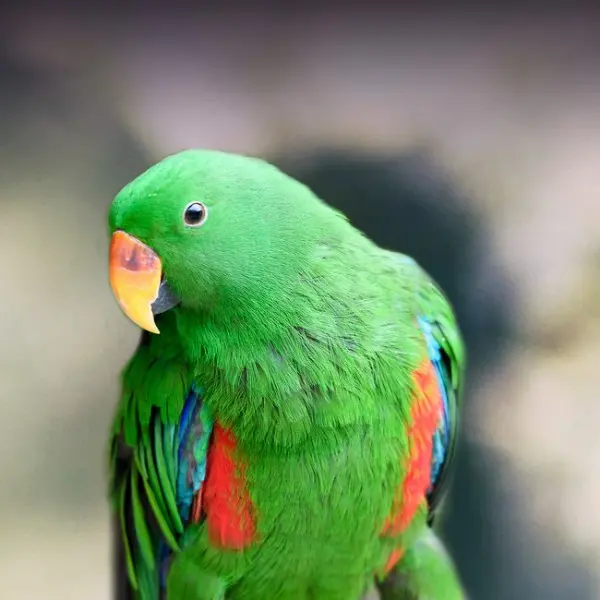
Physical Characteristics
The Eclectus Parrot is one of nature’s most visually captivating species, defined by a range of distinct physical traits that make it stand out in the avian world.
Standing at approximately 35 to 50 cm in length and weighing between 400 to 600 grams, they are medium-sized parrots. Strikingly, they exhibit one of the most pronounced examples of sexual dimorphism found in birds. The males are predominantly emerald green, with a splash of red and blue on their wings, and bright orange beaks; a sight reminiscent of a lush rainforest. In contrast, the females are a dazzling display of crimson and purple, with a stark black beak. This divergence not only aids in species identification but also plays a role in mate bonding and social interactions. Their feathers, lacking barbules, give them a softer, silken appearance and feel, adding to their unique allure.
Sexual Dimorphism
The Eclectus Parrot provides a textbook example of sexual dimorphism, one of the most extreme within the avian world.
- Coloration and Plumage:
- Male Eclectus Parrots: Characterized by their brilliant green plumage accented with red and blue patches on their wings, males exude a visual splendor that is both striking and distinguished. Their vibrant coloration is not just for show; it plays a vital role in their identification and mating strategies. Much like an artist’s palette, the interplay of colors serves multiple functions, from camouflage in dense foliage to an attractive display during courtship.
- Female Eclectus Parrots: By contrast, females showcase a stunning array of vibrant reds and purples. The deep red body is interspersed with purple-blue underbellies and underwing linings. This stark contrast historically led to the belief that males and females were entirely different species. Their vibrant coloration serves as a clear identifier in the dense rainforest and helps in forming social bonds and hierarchical structures.
- Size and Build:
- Eclectus Parrots typically measure between 31 to 37 cm in length, with a robust body and relatively short legs. The females are slightly stockier and less streamlined compared to the sleeker, more streamlined males. This difference, although subtle, aids in the adaptation to their particular ecological niches.
- Beaks and Eyes:
- The beak is another distinguishing feature; males have brightly colored orange beaks, transitioning to yellow at the tip, while females sport solid black beaks. This difference further emphasizes their dimorphism. Eye color also varies; males usually have irises that range from yellow to orange, whereas females have darker irises that gradually lighten with age.
- Feather Structure and Texture:
- Unlike other birds, Eclectus Parrots have feathers that lack barbules, giving them a softer, almost velvety feel. This unique feather structure not only adds to their tactile appeal but also has an aesthetic quality, contributing to their distinctive look.
Size and Weight
The Eclectus Parrot’s size and weight are integral to understanding their physical characteristics and how they navigate their environment.
- General Size:
- These parrots are medium-sized, with lengths ranging from 35 to 50 cm (14 to 20 inches) and wingspans that can extend up to 20 inches (50 cm). This size allows them to maneuver adeptly through the dense canopies of rainforests, a critical skill for foraging and evading predators.
- Weight Range:
- Eclectus Parrots typically weigh between 400 to 600 grams (12.5 to 21.5 ounces). Males and females exhibit slight variations in weight, with males generally being heavier and larger than females. The robustness of their body structure aids in survival in various environments, from dense jungles to open woodlands.
- Comparison with Other Parrots:
- When compared to other parrot species, the Eclectus Parrot is relatively average in size, falling between smaller species like the Budgerigar and larger ones like the Macaw. Their weight and size offer an optimal balance for agility and endurance, crucial for their active lifestyle.
- Physiological Impact:
- The size and weight also influence their diet and metabolic needs. Being medium-sized birds, Eclectus Parrots require substantial calories derived from a diet rich in fruits, seeds, and nuts. Their physical stature demands a balanced diet to maintain energy and health, fully utilizing their robust digestive system.
Coloration and Plumage
One of the most captivating aspects of the Eclectus Parrot is its mesmerizing coloration and unique plumage.
- Males:
- Male Eclectus Parrots shine in bright green plumage with red and blue accents on their wings and underparts, creating a striking visual contrast. This coloration not only aids in blending into their lush, green habitats but also in signaling to other birds and potential mates. The vibrant green feathers reflect the verdant landscapes of their native rainforests, making them almost appear as living emeralds.
- Females:
- Female Eclectus Parrots are encased in rich, red feathers with blue or purple on their bellies and underneath their wings. This dramatic difference in coloration serves as a visual distinction and plays a significant role in their social structure and mating rituals. The bright red and purple colors of the females stand out starkly against the green foliage, acting as visual beacons in their native habitats.
- Feather Structure:
- The feathers of Eclectus Parrots are softer and more velvety compared to other parrots due to the lack of barbules. This unique texture not only adds to their visual and tactile appeal but also affects how light reflects off their feathers, enhancing their vibrant colors.
- Coloration Role and Evolution:
- The striking dimorphism in color is believed to have evolved for specific roles; males, being brighter green, blend into foliage while foraging, whereas females, with their bold red and purple, are more noticeable while guarding nests. This evolutionary adaptation ensures both genders can perform their respective roles efficiently within their ecological niche.
, the Eclectus Parrot’s physical characteristics, including their vibrant coloration, size, weight, and unique feather structure, contribute to their visual appeal and play vital roles in their survival and social interactions.
Habitat and Distribution
Eclectus Parrots inhabit a wide range of environments, primarily in tropical and subtropical regions. Their habitat preferences reflect their ecological adaptability and the richness of their native regions. These parrots thrive in diverse areas, from dense rainforests to less densely wooded savannas and mangroves.
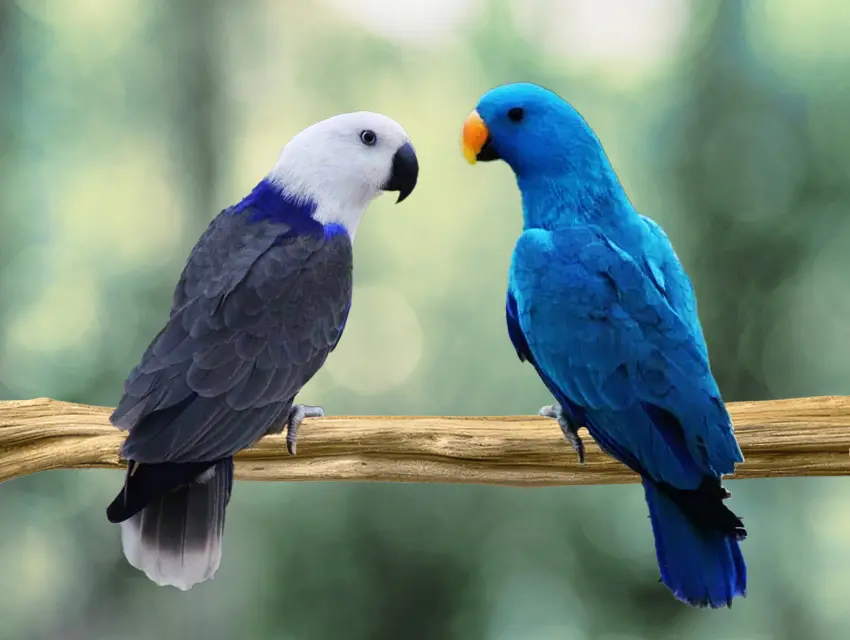
Native Regions
Eclectus Parrots have a geographical distribution that spans several nations and islands, showcasing their adaptability to various environments.
- Primary Locations:
- New Guinea: This region, including the island of New Guinea and its surrounding smaller islands, is a significant habitat for Eclectus Parrots. The dense rainforests here provide abundant food and ideal nesting sites.
- Solomon Islands: These islands offer a lush, tropical environment that supports a rich biodiversity, making it a perfect habitat for these parrots.
- Northeastern Australia: The Parrots are found in the canopied rainforests and eucalyptus forests of this region, thriving in the subtropical climate.
- Moluccas (Maluku Islands): This chain of islands in Indonesia is another vital region where these parrots are commonly found.
- Preferred Environments:
- Rainforests: The dense, humid rainforests are the primary habitat for Eclectus Parrots. These environments provide a continuous supply of fruits, nuts, and seeds, key components of their diet.
- Mangroves and Eucalyptus Forests: Apart from rainforests, they are also found in mangroves and eucalyptus forests. These areas are particularly favored for nesting and foraging.
- Savannas and Coastal Areas: Although less common, Eclectus Parrots also inhabit savannas and coastal areas, especially where large trees are available for nesting.
- Adaptation Strategies:
- The Eclectus Parrot’s ability to adapt to different environments is remarkable. They can thrive in primary and secondary forests, showing flexibility in feeding and nesting habits, which aids their survival amidst changing environmental conditions.
Nesting Habits
Nesting is a critical aspect of the life cycle of Eclectus Parrots, reflecting their complex behavior and adaptations.
- Nesting Sites:
- Tree Cavities: Eclectus Parrots typically nest in natural tree hollows, often high up in large trees. These sites provide safety from ground predators and a stable environment for raising their young.
- Nesting Depths: The depth of these nests can range from 50 cm to as deep as 6 meters, providing ample space for the female and her eggs.
- Nesting Materials:
- The nest is usually lined with decayed wood dust and chips, creating a soft bed for the eggs and chicks. This material helps maintain the necessary humidity and temperature inside the nest cavity.
- Breeding Behavior:
- Egg Laying and Incubation: A female Eclectus typically lays between 2 to 4 eggs per clutch. The incubation period lasts about 26 to 28 days, during which the female remains in the nest while the male provides food.
- Chick Development: Once hatched, the chicks remain in the nest for about 12 weeks. Both parents are involved in feeding and protecting the chicks until they are ready to fledge.
- Nesting Preferences by Subspecies:
- Different subspecies of Eclectus Parrots may show variations in their nesting preferences based on their native environments. For instance, those in the Solomon Islands may prefer coastal mangroves, while those in New Guinea often nest in the dense forest canopies.
Environmental Preferences
Understanding the environmental preferences of Eclectus Parrots is key to their conservation and care.
- Tropical Rainforests:
- Primary preference for humid, dense forests where there is a rich supply of fruits, flowers, and seeds. These environments provide shelter, food, and nesting sites.
- Food Sources:
- Their diet in the wild includes a wide variety of fruits like mangoes, papayas, figs, and berries, as well as nuts and seeds. This diverse diet reflects the abundance of food available in their natural habitats.
- Climate Adaptations:
- Eclectus Parrots are well-adapted to tropical climates, thriving in temperatures ranging from 20°C to 30°C (68°F to 86°F). Their habitats often have high humidity levels, which are crucial for their feather and skin health.
- Elevation Range:
- These parrots are typically found at elevations below 1900 meters (about 6200 feet), reflecting their preference for lowland and mid-elevation forests.
- Human Influence:
- Eclectus Parrots have shown some adaptability to human-altered landscapes, including agricultural areas and plantations where food is plentiful. However, habitat destruction due to deforestation and logging poses significant threats to their populations.
, the Eclectus Parrot’s habitat and distribution highlight their adaptability and the importance of their natural environments. Understanding these aspects is crucial for their conservation and effective care in captivity.
Behavior and Social Structure
The Eclectus Parrot’s behavior and social structure are intricately tied to their need for social interaction, communication, and cooperative breeding. Understanding these aspects provides insights into their complex social dynamics and their needs as pets.
Vocalizations and Communication
Vocalization plays a central role in the life of an Eclectus Parrot, serving various functions within their social structure.
- Variety of Sounds:
- Eclectus Parrots have a diverse vocal repertoire, ranging from natural calls and alarm sounds to complex mimicry of human speech. Their vocal expressions are not merely for communication but also for social bonding and interaction.
- Natural Calls: These calls are used to communicate within the flock, announce presence, and maintain contact in dense forest habitats where visibility is limited.
- Alarm Calls: Sharp, loud sounds are employed to warn other flock members of potential dangers. These alarms play a crucial role in the survival of the group.
- Mimicry: In captivity, Eclectus Parrots can learn to mimic human speech and other sounds in their environment. This ability highlights their intelligence and adaptability.
- Functions of Vocalizations:
- Identification: Vocalizations help in recognizing individuals, which is essential in dense habitats.
- Bonding: Gentle calls and sounds are used between mates and from parents to offspring, reinforcing social bonds and relationships.
- Environmental Interaction: Vocalizations also serve to interact with the environment, from attracting mates to deterring predators.
- Personality Expression:
- Each Eclectus Parrot may develop unique calls and vocal patterns, reflecting their individual personality and emotional state. This uniqueness is often recognized by their flock members and human companions.
Social Behaviors
Eclectus Parrots are inherently social, and their behaviors reflect the importance of social bonds in their lives.
- Cooperative Breeding:
- Several females may share a nesting site, with multiple males assisting in maintenance and protection of the nest. This communal nesting behavior showcases a high level of social interaction and mutual support.
- Flock Dynamics:
- In the wild, Eclectus Parrots live in flocks. These flocks exhibit complex social structures where individual roles and hierarchies help maintain the stability and efficiency of the group.
- Mutual Grooming: Grooming each other is a common behavior that helps in establishing social bonds and maintaining group cohesion.
- Interaction with Humans:
- These parrots form strong social bonds with their human companions, requiring regular interaction to thrive. They are affectionate and enjoy being part of social activities, which helps in their mental stimulation and well-being.
Training and Interaction
The intelligence and social nature of Eclectus Parrots make training and interactive play essential for their care.
- Intelligence and Trainability:
- Eclectus Parrots are highly trainable and can learn a significant vocabulary, perform tricks, and respond to commands. Positive reinforcement, such as treats and verbal praise, is an effective training strategy.
- Engaging Activities:
- Interactive play and mental stimulation through toys, puzzles, and foraging activities are crucial. These activities help prevent boredom and behavioral issues like feather plucking.
- Bonding Time:
- Spending quality time with the parrot daily is essential. Activities like talking, playing, and gentle handling help in building a strong bond, ensuring the parrot feels secure and loved.
- Consistency in Training:
- Consistent training sessions are important. Establishing a routine of short, regular sessions helps in reinforcing learning and behavior.
Summary
Understanding the behavior and social structure of Eclectus Parrots is key to their care. Their complex vocalizations, social behaviors, and training needs highlight the importance of interaction, mental stimulation, and affection in their lives. Proper attention to these aspects ensures their health, happiness, and well-being.
Dietary Needs
The dietary needs of Eclectus Parrots are specific and crucial for their health and vibrant appearance. Understanding their natural diet and adapting it for captive care ensures they receive balanced nutrition.
Wild Diet
In the wild, Eclectus Parrots thrive on a varied and natural diet that reflects the rich biodiversity of their habitat.
- Fruits:
- Wild Eclectus Parrots primarily consume a variety of ripe fruits. These fruits provide essential vitamins, especially vitamin A and C, and carbohydrates for energy. Some common fruits in their diet include:
- Mango
- Papaya
- Fig
- Pomegranate
- Melon
- Various berries
- Wild Eclectus Parrots primarily consume a variety of ripe fruits. These fruits provide essential vitamins, especially vitamin A and C, and carbohydrates for energy. Some common fruits in their diet include:
- Vegetables and Greens:
- While fruits form the staple of their diet, they also forage for soft green leaves and tender shoots. These vegetables and greens are vital sources of fiber and minerals, contributing to their digestive health.
- Seeds and Nuts:
- Seeds and nuts are consumed in moderation as they provide healthy fats and proteins. These components are essential for their energy needs but must be balanced to avoid high-fat intake.
- Flowers and Buds:
- Flowers and flower buds are significant in their diet, offering a variety of nutrients. Foraging for these food sources is a crucial part of their natural behavior, promoting mental stimulation and physical activity.
- Water:
- Fresh water is essential for hydration. In the wild, they obtain water from rain and the moisture in fruits, which supports various physiological functions, including digestion and nutrient absorption.
Recommended Diet for Companions
Adapting the wild diet to a recommended diet for captive Eclectus Parrots ensures they receive balanced nutrition and maintain optimal health.
- Pellets:
- Approximately 50% of their diet should consist of high-quality pellets specifically formulated for Eclectus Parrots. These pellets ensure they receive necessary vitamins and minerals.
- Fruits and Vegetables:
- About 60-80% of their diet should be fresh fruits and vegetables. A variety of produce ensures a broad spectrum of nutrients. Fresh items should be available daily and washed thoroughly to remove pesticides or harmful chemicals.
- Sprouted Seeds and Legumes:
- Around 20% of the diet can include sprouted seeds, legumes, and pulses. These foods provide additional nutrients and aid digestion.
- Cooked Foods:
- Cooked foods, such as boiled eggs or cooked meats, can be given in moderation, ensuring they do not contain harmful preservatives or additives. This should account for approximately 20% of their diet.
Nutritional Considerations
Understanding the unique nutritional needs of Eclectus Parrots is key to preventing deficiencies and maintaining their vibrant health.
- Vitamins and Minerals:
- Eclectus Parrots have heightened needs for Vitamin A, E, and calcium. Fruits like papaya and cantaloupe, and dark leafy greens are excellent sources. Ensuring these nutrients are present in their diet prevents deficiencies that could lead to health issues.
- Fat Content:
- Their diet should be low in fat since Eclectus Parrots can easily gain weight. Seeds and nuts, while nutritious, should be given sparingly to avoid obesity.
- HydHydration**:
It’s crucial to ensure that Eclectus Parrots have access to fresh, clean water at all times, as hydration is essential for digestion, nutrient absorption, and overall health. Regularly monitoring their drinking habits is important, as changes might indicate health issues that need to be addressed promptly.
Foods to Avoid
Certain foods can be toxic or harmful to Eclectus Parrots and must be strictly avoided to prevent health issues.
- Avocado: Contains persin, which is toxic to birds and can cause cardiovascular damage or death.
- Rhubarb: Contains high levels of oxalic acid, which can be harmful.
- Apple Seeds: Contain cyanide, which is poisonous.
- Chocolate: Contains theobromine, which is toxic to birds.
- Caffeine: Found in beverages like coffee, tea, and soda, caffeine is harmful and can cause serious health problems.
- High-fat or Processed Foods: Foods high in fat or heavily processed can lead to obesity and other health issues.
Ensuring that none of these items make it into the Eclectus Parrot’s diet is essential for their well-being.
Summary
The recommended diet for Eclectus Parrots should closely mimic their natural diet, focusing on fresh fruits and vegetables, high-quality pellets, and occasional protein sources like boiled eggs. It’s crucial to maintain a varied diet that meets their specific nutritional needs while avoiding harmful foods. Consulting with an avian veterinarian can provide tailored dietary advice to ensure optimal health for your Eclectus Parrot.
Care and Maintenance
Taking care of an Eclectus Parrot involves not only providing a proper diet but also ensuring their living environment and overall well-being are maintained to high standards. This includes suitable housing, health care, and daily routines that stimulate their physical and mental health.
Cage Requirements
Providing a spacious and well-designed cage is essential for the health and happiness of an Eclectus Parrot.
- Cage Size:
- Minimum Dimensions: The minimum cage size should be 24 x 36 x 48 inches (61 x 91 x 122 cm), but larger is always better. A more ideal size would be between 4 to 6 feet (100-150 cm) high with a floor space of 2 feet by 3 feet (60 x 100 cm). This space allows for ample movement and play, which is critical for their active nature.
- Bar Spacing and Material:
- Spacing: The spacing of the bars should be between 0.75 and 1.5 inches (1.9-3.8 cm) to prevent the Eclectus from escaping or getting stuck.
- Material: The cage should be made of sturdy, non-toxic materials. Stainless steel cages are often recommended due to their durability and ease of cleaning.
- Perches and Toys:
- Perches: Multiple perches of varying diameters and materials (preferably natural wood) should be installed to promote healthy feet.
- Toys: A variety of toys should be provided to stimulate their intelligence and cater to their natural foraging behaviors. These should include interactive toys, foraging puzzles, and chewable items. Rotation of toys is crucial to keep their environment engaging.
- Bedding and Cleanliness:
- The bottom of the cage should be lined with bedding material that’s easy to clean, such as paper or commercially available bird-safe bedding. Regular cleaning is paramount to prevent bacterial build-up.
Health and Veterinary Care
Regular veterinary checkups and constant monitoring of their health are crucial for early detection of potential issues.
- Common Health Issues:
- Obesity: Monitor their weight and diet, ensuring they don’t consume too many high-fat foods.
- Feather Cysts: Look for unusual lumps under their skin. If noticed, a vet should be consulted immediately.
- Respiratory Issues: Symptoms like wheezing, coughing, or nasal discharge require immediate veterinary attention.
- Viral and Bacterial Infections: Regular health checkups can help detect and treat these early.
- Preventive Care:
- Vaccinations: Ensure they are up-to-date on necessary vaccinations.
- De-worming: Regular de-worming treatments as recommended by an avian vet can prevent parasitic infections.
- Dental Health:
- While they do not have teeth, beak health is crucial. Providing chewable toys and a balanced diet helps maintain beak strength and integrity.
Daily Care Routine
A structured daily care routine is essential to the well-being of an Eclectus Parrot.
- Feeding Schedule:
- Provide fresh food and water daily. Fruits and vegetables should be given in the morning and removed after a few hours to prevent spoilage.
- Pellets and seeds can be left available throughout the day.
- Social Interaction and Play:
- Eclectus Parrots thrive on social interaction. Allocate at least one to two hours of out-of-cage time daily in a safe, supervised environment. Social interaction with family members through play, training, or just spending time together is vital.
- Cleaning and Hygiene:
- Daily cleaning of food and water dishes.
- Spot cleaning of the cage to remove any soiled materials.
- Weekly cleaning of perches, toys, and thorough disinfection of the cage at least once a month.
- Bathing:
- Provide regular bathing opportunities. This can be through misting or providing a shallow dish of water. Bathing helps in maintaining feather health and cleanliness.
Summary
Proper care and maintenance of Eclectus Parrots involve providing a spacious and stimulating environment through an appropriately sized cage, regular health checkups, preventive care measures, and a structured daily routine. Ensuring their physical and mental stimulation as well as maintaining cleanliness are essential to their overall health and well-being.
Breeding and Reproduction
Understanding the breeding and reproductive behaviors of Eclectus Parrots is essential for those interested in breeding these birds in captivity.
Mating Habits
- Polygamous Breeding:
- Female Eclectus Parrots may mate with multiple males, a behavior referred to as polygamy. This system allows for communal breeding, where various males contribute to feeding the female and the offspring. This breeding strategy increases genetic diversity and chances of offspring survival.
- Courtship and Pair Bonds:
- Although they can practice polygamy, Eclectus Parrots are also known to form strong pair bonds, which can last a lifetime. These bonds are characterized by mutual grooming, feeding, and close association.
- Breeding Age and Season:
- Breeding Age: Eclectus Parrots typically reach sexual maturity between 2 to 4 years of age.
- Breeding Season: In their natural habitat, the breeding season generally spans from November to April. In captivity, breeding can occur year-round if the environmental conditions are optimal.
Nesting and Incubation
- Nesting Sites:
- Tree Hollows: In the wild, they favor tree hollows for nesting. In captivity, providing a large nesting box is crucial to mimic their natural nesting habits.
- Nesting Box Requirements: Nesting boxes should ideally be 31–39 inches in height, with an inside diameter of 12–14 inches and an opening of 4–5 inches. The interior should be lined with wood shavings or coconut fibers.
- Incubation:
- Clutch Size: Females usually lay between 2 to 3 eggs per clutch.
- Incubation Period: The female incubates the eggs for approximately 26 to 30 days. During this period, the male often provides food for the female.
- Hatching: After hatching, chicks remain in the nest for about 12 weeks and rely heavily on their parents for nourishment and protection.
Chick Care
- Parental Care:
- Chicks are altricial, meaning they are born relatively helpless and depend entirely on their parents for feeding and warmth. Both parents are involved in feeding the chicks through regurgitation, ensuring they receive adequate nutrition.
- Development and Weaning:
- Chicks remain in the nest for about 8 weeks, during which they start to develop feathers and learn essential survival skills.
- Fledging: By approximately 12 weeks, chicks are ready to fledge (leave the nest) and gradually become independent.
- Diet:
- A balanced diet for the parents during the breeding season ensures healthy chick development. This includes a variety of fruits, vegetables, and specially formulated pellets.
Behavioral Context
- Communal Breeding:
- The communal breeding behavior of Eclectus Parrots involves cooperation among multiple birds, reflecting complex social interactions and support systems within their groups. This behavior is adapted to the limited availability of nesting sites in their natural habitat, leading to cooperation and competition among breeding pairs.
- Female Dominance:
- Female Eclectus Parrots often exhibit more assertive and dominant behaviors, particularly during the breeding season. This dominance is crucial for safeguarding the nest and chicks.
Summary
Breeding and reproduction in Eclectus Parrots are characterized by strong pair bonds, polygamous breeding, and cooperative care of offspring. Understanding their nesting preferences, incubation period, and chick care practices is essential for successful breeding in captivity.
Common Health Issues
Recognizing and addressing common health issues in Eclectus Parrots is crucial for ensuring their well-being.
Signs of Illness
- Feather Plucking:
- Feather plucking is a common behavioral issue among Eclectus Parrots. It can be triggered by stress, nutritional deficiencies, or environmental factors. Signs include excessive feather loss, particularly around the chest and wings, or shortened and damaged feathers known as “barbering.”
- Respiratory Infections:
- Respiratory issues manifest through symptoms like wheezing, coughing, nasal discharge, and labored breathing. These infections can result from poor air quality, exposure to pollutants, or inadequate care conditions.
- Nutritional Deficiencies:
- Hypovitaminosis A: This condition arises due to a lack of vitamin A in the diet. Symptoms include white patches on the mouth or tongue, poor feather quality, and susceptibility to infections.
- Calcium Deficiency: Signs include weak bones, beak deformities, and poor muscle function.
- Psittacine Beak and Feather Disease (PBFD):
- PBFD is a viral disease that affects the feathers and beak. Symptoms include abnormal feather growth, feather loss, and changes in beak appearance. It requires immediate veterinary consultation for management.
- Sarcocystosis:
- This parasitic infection can affect muscles and organs, with symptoms like lethargy, weight loss, and changes in appetite. Prompt veterinary treatment is essential.
- Psittacosis:
- Also known as “parrot fever,” this bacterial infection can affect both birds and humans. Symptoms in parrots include respiratory distress, lethargy, and gastrointestinal issues. It requires immediate medical attention.
- Behavioral Changes:
- Any significant changes in behavior, such as withdrawal, aggression, or altered vocalizations, can indicate underlying health issues. Monitoring and prompt response to these changes are vital.
Preventive Measures
- Regular Veterinary Checkups:
- Schedule routine visits to an avian veterinarian at least once a year. These checkups help in early detection of diseases and monitoring overall health.
- Vaccinations and Preventive Treatments:
- Consult with an avian vet regarding necessary vaccinations and preventive treatments. Regular deworming and vaccinations against diseases like avian influenza and polyomavirus are essential.
- Balanced Diet:
- Provide a well-balanced diet rich in fresh fruits, vegetables, and high-quality pellets. Avoid foods that are toxic to parrots, such as chocolate and avocado.
- Proper Housing and Environment:
- Ensure a clean, spacious cage with proper ventilation. Avoid placing the cage in drafty areas or under direct sunlight to prevent overheating.
- Mental Stimulation and Enrichment:
- Provide a stimulating environment with various toys and activities to prevent boredom and stress-related behaviors like feather plucking.
- Adequate Sleep:
- Ensure the parrot gets 10-12 hours of uninterrupted sleep each night in a quiet, comfortable environment.
- Monitoring Behavioral Changes:
- Be vigilant for any signs of illness or behavioral changes, and seek veterinary advice promptly if any issues arise.
Veterinary Recommendations
- Respiratory Infections:
- Seek immediate veterinary care for respiratory issues like wheezing or nasal discharge. Ensure the living environment is clean and well-ventilated.
- Nutritional Deficiencies:
- Consult with an avian vet if signs of malnutrition appear, to adjust the parrot’s diet and possibly introduce supplements.
- Feather Plucking and Behavior Problems:
- Behavioral issues like feather plucking often indicate stress or discomfort. A vet can suggest strategies such as behavioral modification and environmental enrichment to address these issues.
- PBFD and Viral Diseases:
- Immediate veterinary consultation is necessary for viral diseases like PBFD. Regular health checkups can help with early detection and management.
Summary
Recognizing signs of illness and implementing preventive measures are essential for maintaining the health of Eclectus Parrots. Regular veterinary checkups, a balanced diet, a clean and stimulating environment, and prompt attention to any changes in behavior or health are key to ensuring their well-being.
Eclectus Parrot as Pets
Eclectus Parrots make captivating and affectionate pets, suitable for families and individuals willing to invest time and effort into their care. Their unique personalities, intelligence, and striking appearance make them both challenging and rewarding companions.
Personality Traits
- Sociable and Affectionate:
- Eclectus Parrots thrive on interaction with their human companions and form strong bonds readily. They enjoy social activities and need regular attention to avoid loneliness and boredom.
- Intelligent and Trainable:
- These parrots are highly intelligent and capable of learning a wide range of words and phrases. They respond well to training and can pick up tricks and mimic speech effectively through positive reinforcement.
- Curious and Playful:
- Naturally curious, Eclectus Parrots love exploring their surroundings and engaging with toys. Providing a variety of stimulating activities is crucial to keep them entertained and mentally sharp.
- Quiet Nature:
- Compared to other parrot species, Eclectus Parrots are relatively quiet, making them suitable for apartment living. Their vocalizations are less frequent and not as loud, although they can become vocal when alarmed or excited.
- Variance in Individual Temperaments:
- While generally friendly, individual Eclectus Parrots can vary greatly in temperament. Early socialization is key to shaping their behavior, with some parrots being more outgoing and others more reserved.
Suitability for Families
- Interaction with Kids:
- Eclectus Parrots are generally considered suitable pets for families due to their sociable and affectionate nature. They can be great companions for children, provided that interactions are supervised and children are taught to handle the birds gently and respectfully.
- Family Engagement:
- These parrots enjoy engaging with multiple family members and can become playful companions. Their playful nature and striking appearance are often fascinating for kids, who can participate in feeding and training activities under adult supervision.
- Time and Attention:
- Families need to be prepared to dedicate time to the parrot’s care and socialization needs. Regular interaction and mental stimulation are essential to prevent feelings of loneliness and boredom.
- Stable Environment:
- Eclectus Parrots are sensitive creatures that thrive in calm and stable environments. Stressful situations can negatively impact their behavior, so a peaceful household is crucial for their well-being.
Interaction with Children
- Gentle Handling:
- Children should be taught how to interact gently and respectfully with the parrot. Emphasizing the importance of not startling or handling the bird roughly is crucial to fostering a positive relationship.
- Supervised Interaction:
- Always supervise interactions between young children and the parrot to ensure the safety and comfort of both. Supervised play sessions can be a great way for children to bond with the bird.
- Educational Value:
- Having an Eclectus Parrot can be educational for children, teaching them about responsibility, animal care, and the importance of empathy for living creatures.
- Boundaries and Respect:
- Children should also learn about the parrot’s boundaries and respect its space and needs. Understanding when the bird wants to be left alone or needs quiet time is important in building trust.
Summary
Eclectus Parrots can make wonderful family pets, particularly in households with children, provided that interactions are supervised, and children are educated on handling the birds kindly. Their intelligence, sociability, and unique personalities make them rewarding companions, although they require considerable attention and care.
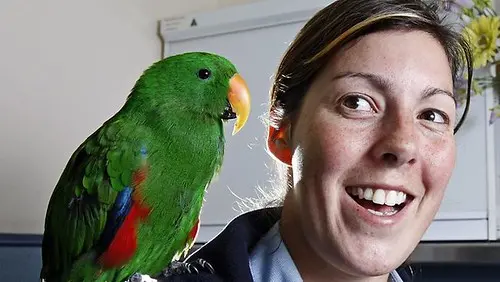
Conservation Status
The conservation status of Eclectus Parrots reflects both their adaptability and the threats they face in the wild.
Habitat Threats
- Habitat Destruction:
- One of the primary threats to the Eclectus Parrot is habitat destruction due to deforestation for agriculture and urban development. The conversion of forests to farmlands and urban areas reduces the availability of suitable nesting sites and food sources.
- Logging Activities:
- Logging activities in tropical rainforests also pose significant threats by diminishing the trees that serve as natural nesting sites for these parrots. The loss of tree hollows impacts their ability to breed successfully.
- Climate Change:
- Climate change can alter the habitats of Eclectus Parrots, affecting the availability of food and suitable living conditions. Changes in rainfall patterns and temperature can disrupt their natural breeding and feeding behaviors.
- Illegal Pet Trade:
- The illegal pet trade is another major threat. Poaching and trapping of wild parrots for the pet market can lead to population declines. The transportation and handling of these birds in the trade often result in high mortality rates.
Conservation Efforts
- Protected Areas:
- Establishing protected areas and national parks can help conserve their natural habitats. Ensuring that these areas are well-managed and protected from illegal activities is crucial.
- Habitat Restoration:
- Restoring degraded habitats through reforestation and community-based conservation projects can provide long-term benefits for Eclectus Parrots. Planting native tree species that offer food and nesting sites helps in their recovery.
- Legal Protections:
- Enforcing stronger legal protections against deforestation, logging, and illegal pet trade is essential. Countries within the Eclectus Parrot’s range need to collaborate on conservation policies and laws.
- Captive Breeding Programs:
- Captive breeding programs can help sustain captive populations and reduce the pressure on wild populations. These programs must adhere to ethical standards and contribute to conservation efforts by breeding pure subspecies.
- Public Awareness and Education:
- Raisingpublic awareness and education about the importance of preserving Eclectus Parrots and their habitats can foster community involvement in conservation efforts. Initiatives can include:
- Community Engagement:
- Involving local communities in conservation projects helps create sustainable habitats and offers economic incentives for conservation over exploitation. Educating locals on the ecological role of Eclectus Parrots can generate support for protective measures.
Summary
While the Eclectus Parrot is currently classified as “Least Concern” on the IUCN Red List, continuous threats such as habitat destruction, illegal pet trade, and climate change can impact their populations. Conservation efforts, including habitat restoration, protected area enforcement, legal protections, and community education, are essential for ensuring the long-term survival of these captivating birds.
Popular Subspecies
Eclectus Parrots are divided into several subspecies, each with its unique characteristics. Understanding these differences can help in the identification and care of these birds.
Grand Eclectus
The Grand Eclectus (Eclectus roratus roratus) is a highly recognized subspecies, celebrated for its brilliant coloration and distinct sexual dimorphism.
- Habitat and Distribution:
- Found primarily in the central and southern Maluku Islands, such as Ambon, Buru, Seram, and the Lease Group in Indonesia. These islands feature variations in size and coloration among the Grand Eclectus populations, reflecting their adaptation to different local environments.
- Physical Characteristics:
- Males are a vivid green with some blue at the wing edges and red underwings, while females display a rich red body with a dull purple upper mantle and abdomen. These vibrant colors help in species identification and play roles in mating displays.
- The typical size ranges from 30.5 to 35 cm in length with a wingspan around 50 cm.
- Behavioral Traits:
- Known for their sociable and friendly nature. They are capable of mimicking sounds and human speech, making them fascinating pets. Their laid-back demeanor suits calm environments.
- Engage in communal breeding, demonstrating strong social bonds within their groups.
- Diet:
- Wild diets include fruits, seeds, nuts, and nectar. Captive diets should encompass fresh fruits and vegetables, along with specially formulated seed mixes enriched with vitamins.
- Conservation Status:
- Listed as Least Concern on the IUCN Red List, but threats include habitat destruction and the pet trade. Conservation efforts are vital for maintaining their populations in the wild.
Vosmaeri Eclectus
The Vosmaeri Eclectus (Eclectus roratus vosmaeri) is renowned for its stunning appearance and popularity in aviculture.
- Habitat and Distribution:
- Native to the northern Maluku islands of Halmahera, Obi, Bacan, and Sula in Indonesia.
- Physical Characteristics:
- Females feature a bright red body transitioning to lavender, with yellow under-tail coverts and a bright yellow band on the tail tip. Males are vivid green with some red patches, generally larger than those in other subspecies like the Grand Eclectus.
- Behavioral Traits:
- Known for their beauty and amiable nature, making them highly sought after as pets. Hand-rearing improves socialization skills, making them affectionate companions.
- Display intelligence and sociability, engaging well with human companions.
- Diet:
- Similar dietary needs to other Eclectus subspecies, with a focus on fresh produce and balanced nutrition to maintain their vibrant plumage and health.
Solomon Island Eclectus
The Solomon Island Eclectus (Eclectus roratus solomonensis) is the most commonly kept Eclectus subspecies in captivity.
- Habitat and Distribution:
- Found predominantly in the Solomon Islands, where they thrive in the rich, varied flora of the region.
- Physical Characteristics:
- Males are brightly green with yellowish-green wing coverts and bright red underwings. Females are predominantly bright red with blue and purple hues on the belly and wings, creating a vivid contrast.
- They are generally smaller and exhibit more defined color contrasts compared to other subspecies.
- Behavioral Traits:
- Renowned for their gentle disposition and laid-back personality. They enjoy interaction with their human companions, making them ideal pets for those preferring a calmer bird.
- Display a high degree of adaptability, both in wild and captive environments.
- Diet:
- Like other Eclectus subspecies, they require a diet rich in fresh fruits, vegetables, and balanced pellets.
Red-Sided Eclectus
The Red-Sided Eclectus (Eclectus roratus polychloros) is a popular subspecies, known for its vibrant coloration and moderate size.
- Habitat and Distribution:
- Found primarily in the West Papuan islands of Indonesia and mainland New Guinea.
- Physical Characteristics:
- Males exhibit a bright green plumage with red and blue accents, while females show deep scarlet to bright red feathers with a blue feather ring around the eye and a blue-purple breast. These striking colors play crucial roles in their social interactions and mating rituals.
- Typically measures between 12 to 14 inches in length and weighs approximately 380 to 450 grams.
- Behavioral Traits:
- Known for their laid-back demeanor, the Red-Sided Eclectus tends to be less noisy compared to other parrot species. They form strong bonds with their owners and exhibit a degree of aloofness.
- Breeding season peaks in spring but can occur year-round under optimal conditions. Males contribute substantially to nesting and chick-rearing.
- Diet:
- They require a balanced diet, similar to other Eclectus subspecies, emphasizing fresh fruits, vegetables, and formulated pellets. Supplements are generally unnecessary if the diet is properly managed.
- Conservation Status:
- Their population is stable and locally common, listed in Appendix II of CITES, regulating international trade. Breeding in captivity is regular, although maintaining pure subspecies can be challenging.
Summary
The various subspecies of Eclectus Parrots, including the Grand, Vosmaeri, Solomon Island, and Red-Sided Eclectus, each exhibit unique characteristics in terms of appearance, behavior, and habitat preferences. Understanding these differences is crucial for proper care and conservation efforts. Their unique traits and striking colorations make them fascinating subjects for avian enthusiasts and critical components of their native ecosystems.
Understanding the nuances of each subspecies helps in providing the best care in captivity and supports conservation efforts aimed at preserving their natural habitats and genetic diversity. As we continue to learn about these birds, we can appreciate their complexity and the remarkable adaptations that have allowed them to thrive in diverse environments.
